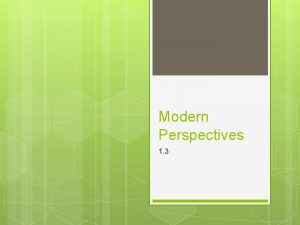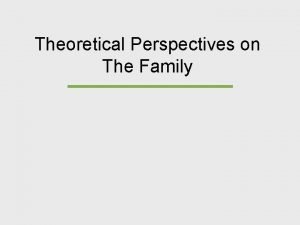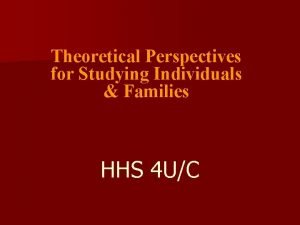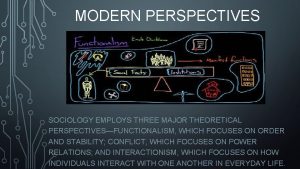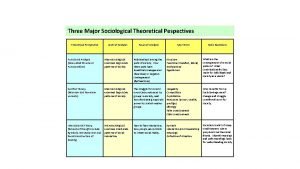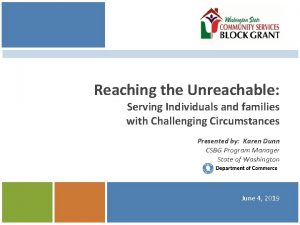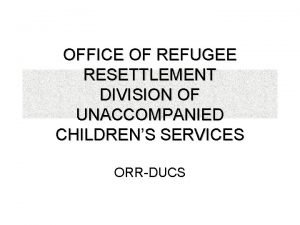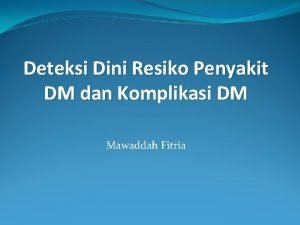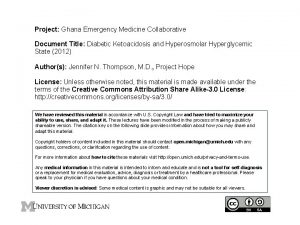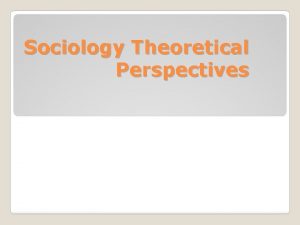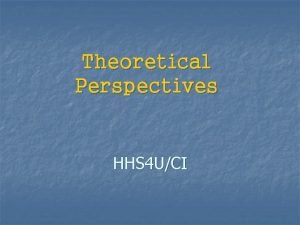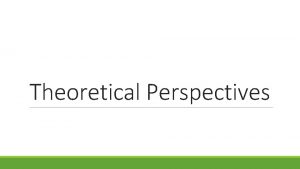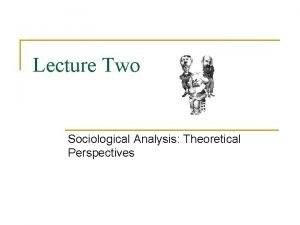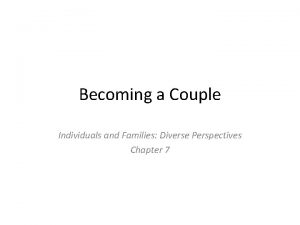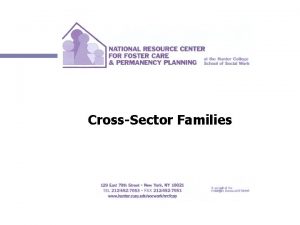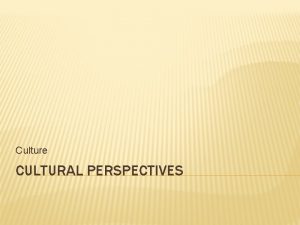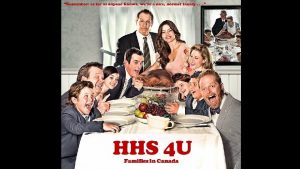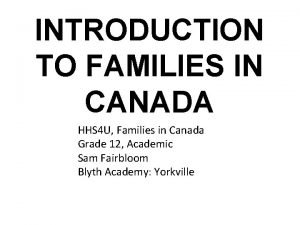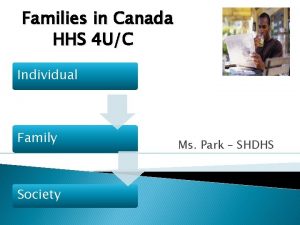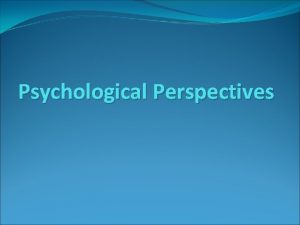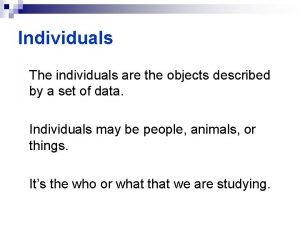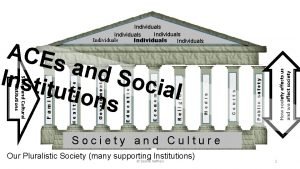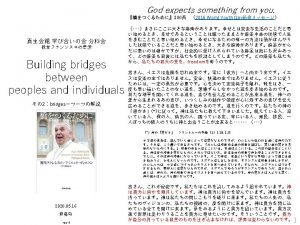Theoretical Perspectives for Studying Individuals Families HHS 4



































- Slides: 35

Theoretical Perspectives for Studying Individuals & Families HHS 4 U/C

Learning Goals n By the end of this lesson you will understand seven theoretical perspectives. n You will be able to compare theories to each other. n You will be able to evaluate the usefulness of each theory.

Norms n n THE RULES OF CONDUCT FOR MEMBERS OF A SOCIETY. change over time as a society’s values change. § Examples: – Divorce laws – Mothers in the labour force – Abortion rights identified in society by watching people’s behaviour – in their ROLES >> creates ‘predictability’. Different cultures have different norms (culture shock!)

Internalization During SOCIALIZATION PROCESS, NORMS are ‘internalized’ and become part of conscience. n You don’t even realize you’ve been PROGRAMMED! n

Theories n When scientists explain their observations, their answers reflect their theories n Some theories have been used to explain human behaviour for many years n Other theories have been revised and replaced n Theories are NOT FACTS, just attempts to explain evidence

Theoretical Perspectives Like “filters” that we look through when studying society; different filter = different view n THEORIES are NOT facts, but rather attempts to explain evidence n – Different theories can attempt to explain same set of observations – Different theory = different explanation

Social Scientists ask four fundamental questions: n What happens? n How does it happen? n Why does it happen? n How can people change what happens?

MICRO vs MACRO Perspectives n MACRO (large scale) theories study the interaction between society and institutions such as the law, family, politics, etc. n MICRO (small scale) theories emphasize the relationships within individual families

Theoretical Perspectives n Functionalism n Systems Theory n Symbolic Interactionism n Social Exchange Theory n Developmental Theories n Conflict Theory n Feminist Theory

Theoretical Perspectives Chart n Complete the handout chart using the text pages 33 – 43. n Provide the following details: What kind of theory is it? (Macro, Micro / Anthro, Psych, Soc, other) What does it attempt to explain? What are the main areas of focus? What are the main concepts and principles? What are its strengths/weaknesses?

Applying the Theories n Briefly explain one of the following topics using the basic principles of each perspective: Legalizing Marijuana Home Schooling Child Abuse

Structural Functionalism n MACRO Approach / Sociology Theory n Attempts to explain how society is organized to perform required functions n Focuses on how institutions, such as the law, political system, and the family function n Assumes societies are stable when structures function to benefit society n http: //www. youtube. com/watch? v=l. E 8 Qu. BDkkw

Structural Functionalism Examine the ROLES individuals play to contribute to the bigger picture – Status = a specific position within a social group – Role = the set of behaviours an individual is expected to demonstrate within a status – Norm = most prevalent behaviours in that role Example: An individual with a “father” status is expected to take on behaviours such as working, child care and providing to fulfill his role. It is the norm for a father to work outside the household. It is abnormal for him to stay home. n

Structural Functionalism n Strengths of Approach: Explains how family interacts with society - Emphasizes family strengths rather than weaknesses - n Weaknesses/Criticisms of Approach: - Does not explain why societies or families change - Change and individual differences are seen as disruptions - Only one acceptable form of family rather than many variations - Doesn’t deal with interpersonal relationships

Systems Theory n n n MICRO AND MACRO / Sociological Theory Attempts to explain how groups of individuals interact as a system and influence each other A system is a set of interrelated parts Family systems have a complex organization Individuals within the system influence each other in a reciprocal way

Systems Theory n The family system changes when a change in one person’s behaviour causes the behaviour of another to evolve n The larger family system contains subsystems (father-child, mother-father) n A genogram diagram depicts the relationships within a family system

Genogram Below is a genorgram of disaese patterns within a family

Systems Theory n Advantages: – Explains the behaviour of individuals as inseparable from the group – Explains why behaviour continues in destructive patterns even through generations n Disadvantages: – Can be difficult to determine how others within the family are influencing an individuals behaviour – Overlooks experience of individuals – Social/Structural factors, such as unemployment are not taken into consideration

Symbolic Interactionism n n n MICRO Approach / Psychological Theory Attempts to explain how individual choose how they will act based on their perceptions of themselves and of others People define and interpret their experiences and give meaning to them Couples Retreat: http: //www. youtube. com/watch? v=0 Tmug. Joc 9 Y&feature=related

Symbolic Interactionism n “Me” =objective qualities (tall, male, student) n “I” = subjective self (good student, shy, lonely) n Role taking = being able to anticipate how other’s will respond n Communication requires common language and use of shared symbols


Cooley’s Looking Glass Self n“I am not what I think I am not what you think I am what I think you think I am”


Symbolic Interactionism n Advantages – Emphasizes mental processes and takes individual perception and interpretations into consideration – Sense of individual control – Explains importance of shared symbols and communication n Disadvantages – Observations of researchers may be influenced by the researchers interpretations – Pays little attention to the impact of wider society and does not explain society-wide changes in families

Social Exchange Theory n MICRO approach / Psychological Theory n Attempts to explain the social factors that influence reciprocal relationships n People act to maximize the benefits and minimize costs to themselves n Individuals interpret their experiences in terms of costs vs. benefits

Social Exchange Theory n Relationships are stable when the benefits that each person receives balance the costs of the relationships n This theory is used to explain how individuals make decisions to form and maintain relationships that may be seen as unacceptable to others

Social Exchange Theories n Weaknesses -A limitation of this theory is that some people are offended by the cost/benefit analysis -Attempts to explain individual behaviour and needs and pays less attention to family dynamics

Developmental Theories n MICRO approach / Interdisciplinary (examines biological, psychological, social and cultural factors that influence development) n Describes patterns to explain growth and change throughout the human life cycle – Developmental Tasks = role expectations that challenge people to develop

Developmental Theories n n Different factors at different ages Outline predictable stages marked by normative events At each stage there are developmental prerequisites One must complete on developmental task to move onto the next

Developmental Theories n Disadvantages – Not all stages will fit all families or individuals – Some families will experience non-normative events such as death of a child, etc – Stages make theory restrictive because they do not always occur in order, or occur at all

Conflict Theory n. A MACRO interdisciplinary sociological and political theory n Explains how power (ability to control the behaviour of another) holds a society together n Conflict exists because of inequalities n Groups compete with each other to meet their needs

Conflict Theory n Describes the relationship of men and women within a family as one of exploitation and oppression, and is used for analyzing power and authority within the family n Developed in the 19 th century when there were large social inequalities in society n Disadvantage – Negative approach

Feminist Theories n. A branch of conflict theories n Developed in the second half of the 20 th century to explain the impact of sex and gender on behaviour n Considers issues from the point of view of women

Feminist Theories n Argue that change is required so that the needs of all people are met n Attempts to explain social inequalities between men and women from a variety of female perspectives n Socialist feminism is based on the assumption that the status of women is a social inequality rooted in the sexual division of paid vs. unpaid labour

Application: Let us now take a look at Teen Suicide from each theoretical perspective.
 Define family matters
Define family matters Three theoretical perspectives
Three theoretical perspectives Theoretical perspectives on the family
Theoretical perspectives on the family Four theoretical perspectives
Four theoretical perspectives Three major theoretical perspectives in sociology
Three major theoretical perspectives in sociology Three theoretical perspectives in sociology
Three theoretical perspectives in sociology Serving individuals and families
Serving individuals and families Serving individuals and families
Serving individuals and families Little families
Little families Hhs diabetes
Hhs diabetes Federal field specialist orr
Federal field specialist orr Hhs diabetes
Hhs diabetes Hhs+ reputation
Hhs+ reputation Hhs office of population affairs
Hhs office of population affairs Jen smyers orr
Jen smyers orr What is aspr
What is aspr Kad vs hhs
Kad vs hhs Hhs diabetes
Hhs diabetes Eplc framework
Eplc framework Hhs
Hhs Bibits hhs
Bibits hhs Diabetic ketoacidosis
Diabetic ketoacidosis Todd simpson hhs
Todd simpson hhs Infant oral health care
Infant oral health care Dka vs hhs
Dka vs hhs Dka vs hhs
Dka vs hhs Hhs sbir sttr
Hhs sbir sttr Dka vs hhs
Dka vs hhs Cdc hhs
Cdc hhs Myndigheten för delaktighet
Myndigheten för delaktighet Läkarutlåtande för livränta
Läkarutlåtande för livränta Treserva lathund
Treserva lathund Tack för att ni lyssnade
Tack för att ni lyssnade Att skriva debattartikel
Att skriva debattartikel Egg för emanuel
Egg för emanuel En lathund för arbete med kontinuitetshantering
En lathund för arbete med kontinuitetshantering

